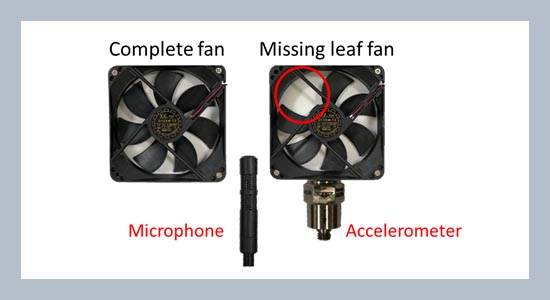Yan-Cheng Chen1, Jiunn-Woei Liaw1, 2, 3* 1 Department of Mechanical Engineering, Chang Gung University, Taoyuan, Taiwan
2 Department of Mechanical Engineering, Ming Chi University of Technology, New Taipei City, Taiwan
3 Medical Physics Research Center, Institute for Radiological Research, Chang Gung University and Chang Gung Memorial Hospital, Taoyuan, Taiwan
Download Citation:
|
Download PDF
Machine learning and deep learning on the health diagnosis of a rotating machine are studied for smart monitoring. The signals of vibration and sound pressure of a rotating fan driven by DC motor detected by an accelerometer and microphone are processed by machine/deep learning for health diagnosis of blade. For the machine learning, two methods, support vector machine (SVM) and random forest (RF), are used for classification of normal and abnormal status based on three features extracted from the signals in time domain and frequency domain. For the deep learning, convolution neural network (CNN) method is used to process the two signals in time domain for modelling; certain layers of convolution and pooling for feature extraction are followed by two layers of artificial neural network. After the learning, a confusion matrix of testing is given to evaluate the performance. In particular, the importance scores of input features are analyzed by RF, which is useful for us to screen out the non-significant features for improving the learning to avoid overfitting. We demonstrate three different methods (SVM, RF, CNN) on the diagnosis of a rotating fan with a damaged blade to illustrate their characteristics.ABSTRACT
Keywords:
Deep learning, Machine learning, CNN, Vibration, Feature extraction, Rotating machine, Acoustic fingerprint, FFT, Confusion matrix, Support vector machine, Random forest, Decision trees, Artificial neural network (ANN).
Share this article with your colleagues
REFERENCES
ARTICLE INFORMATION
Received:
2021-02-08
Revised:
2021-05-21
Accepted:
2021-06-22
Available Online:
2021-06-01
Chen, Y.-C., Liaw, J.-W. 2021. Machine learning and deep learning on health diagnosis of rotating fan. International Journal of Applied Science and Engineering, 18, 2021063. https://doi.org/10.6703/IJASE.202106_18(3).004
Cite this article:
Copyright The Author(s). This is an open access article distributed under the terms of the Creative Commons Attribution License (CC BY 4.0), which permits unrestricted use, distribution, and reproduction in any medium, provided the original author and source are cited.






